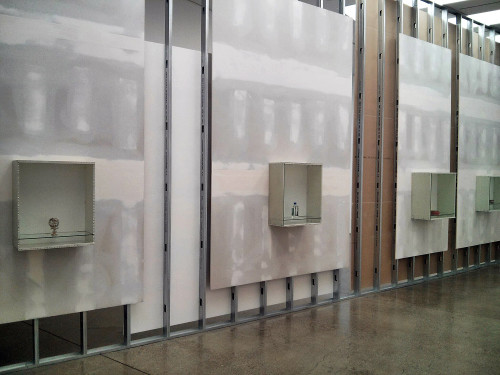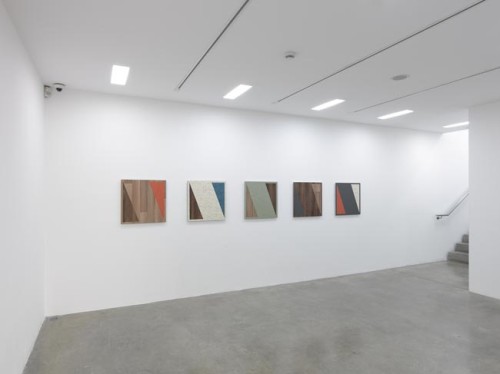The exhibition of found objects can take two forms: either the DuChampian invasion of the “real” into the unreal spaces of art, ironically short-circuiting our expectations and behavior toward both realms of objects; or the museum-like display of found objects as cultural documents or relics, representing their origins and functions in an anthropological matrix. Like many artists working today, when cultural discourse is generally more interesting than art discourse (especially for artists), Haim Steinbach‘s interests lie in the second form, where objects as disparate as Star Wars action figures, bottles of Fiji water, and Chinese headrest can speak in harmony to a globalized movement of things. There is even room for DuChamp’s famous bottle racks, humorously restaged in the form of a custom bookshelf available from OneStar press.
Steinbach’s latest exhibition, Travel, on this last autumn at White Cube‘s stunning Mason Yard gallery space, involved a substantial amount of architectural innovation. The exhibition staged each object in a display box along a span of custom built walls, each built at angles in the gallery, and each revealing various levels of inner construction, skinned at some places to their steel frames and at others patched but unpainted. The rawness of architectural form is a hallmark of Steinbach’s conception of objects in relation to, and structured by, architectural conventions.
At White Cube, Steinbach’s ad-hoc construction undercut the stability of the museological conventions used to exhibit his collection. Despite the use of ordered, sharply detailed vitrine displays, Travel‘s objects hung with evident temporality, as if their international shuffle had been frozen for momentary examination. Steinbach’s interest in material and architecture is seconded by the inclusion of five wall works in the lower ground floor lobby: the artist’s reconstructed Linopanel series (1976) of geocentric abstractions built from flooring materials.
However, the primary work in Travel remains the dozen plus objects displayed throughout the exhibition’s main spaces. Much has changed in the world of art since Steinbach’s first deployments of objects and collections in the 1980s. As the anthropologic potential of objects has been joined to the anthropomorphic uncanniness of things, new questions are being asked about the agency of things, their status as pseudo-entities, and the interface between humans and the stuff around them. While time will tell whether this passing theoretical fad (the literature often borders on the atavistic or absurd) or yet a third way to imagine the ready-made, it is impossible to look at an exhibition like Steinbach’s without wondering about the objects themselves, not only as evidence of international commodity exchange, but as uniquely affective migrants, produced for export and human desire. Unlike many earlier exhibitions, Steichbach’s objects on display in Travel are behind (plexi-) glass, a minor gesture of separation, but just enough to allow for – if not encourage – this sort of reimagining.
Haim Steinbach’s Travel was on display October 2nd, 2013, through November 16th, 2013, at White Cube Mason’s Yard, London.




Post a Comment